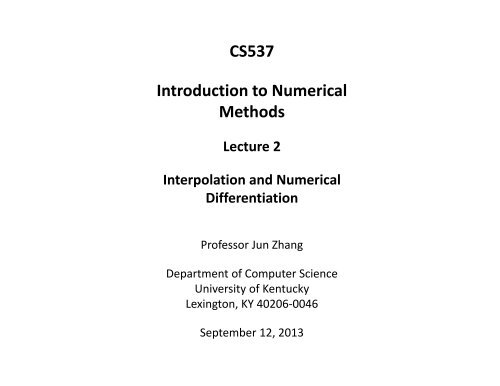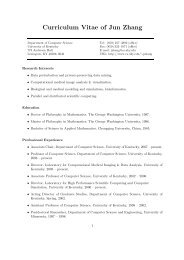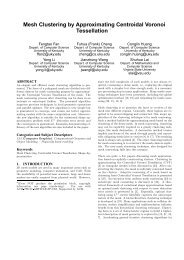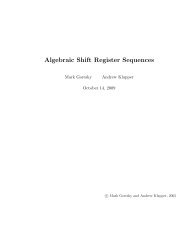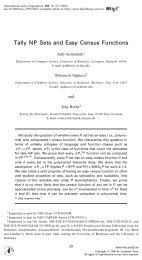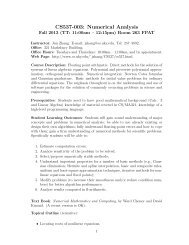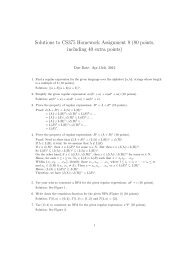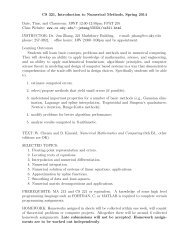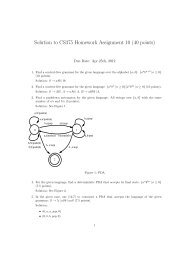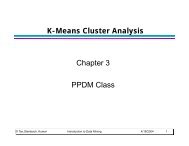1 - Computer Science Department - University of Kentucky
1 - Computer Science Department - University of Kentucky
1 - Computer Science Department - University of Kentucky
You also want an ePaper? Increase the reach of your titles
YUMPU automatically turns print PDFs into web optimized ePapers that Google loves.
CS537<br />
Introduction to Numerical<br />
Methods<br />
Lecture 2<br />
Interpolation and Numerical<br />
Differentiation<br />
Pr<strong>of</strong>essor Jun Zhang<br />
<strong>Department</strong> <strong>of</strong> <strong>Computer</strong> <strong>Science</strong><br />
<strong>University</strong> <strong>of</strong> <strong>Kentucky</strong><br />
Lexington, KY 40206‐0046<br />
September 12, 2013
Polynomial Interpolation<br />
Given a set <strong>of</strong> discrete values, how can we estimate other values<br />
between these data<br />
The method that we will use is called polynomial interpolation.<br />
We assume the data we had are from the evaluation <strong>of</strong> a smooth<br />
function. We may be able to use a polynomial p(x) to approximate this<br />
function, at least locally.<br />
A condition: the polynomial p(x) takes the given values at the given<br />
points (nodes), i.e., p(x i ) = y i with 0 ≤ i ≤ n. The polynomial is said to<br />
interpolate the table, since we do not know the function.<br />
2
Polynomial Interpolation<br />
Note that all the points are passed through by the curve<br />
3
Polynomial Interpolation<br />
We do not know the original function, the interpolation<br />
may not be accurate outside the set <strong>of</strong> data points<br />
4
Order <strong>of</strong> Interpolating Polynomial<br />
A polynomial <strong>of</strong> degree 0, a constant function, interpolates one set <strong>of</strong> data<br />
If we have two sets <strong>of</strong> data, we can have an interpolating polynomial <strong>of</strong><br />
degree 1, a linear function<br />
x x1<br />
x x0<br />
<br />
p(<br />
x)<br />
y0<br />
y1<br />
x0<br />
x1<br />
x1<br />
x0<br />
<br />
Review carefully if the condition is satisfied<br />
<br />
y<br />
0<br />
<br />
<br />
<br />
<br />
y<br />
x<br />
Interpolating polynomials can be written in several forms, the most well<br />
known ones are the Lagrange form and Newton form. Each has some<br />
advantages<br />
1<br />
1<br />
<br />
<br />
y<br />
x<br />
0<br />
0<br />
<br />
(<br />
x x<br />
<br />
0<br />
)<br />
5
Lagrange Form<br />
For a set <strong>of</strong> fixed nodes x 0 , x 1 ,…,x n , the cardinal functions, l 0 , l 1 ,…, l n ,<br />
are defined as<br />
0<br />
if i j<br />
li<br />
( x j ) ij <br />
1<br />
if i j<br />
We can interpolate any function f(x) by the Lagrange form <strong>of</strong> the<br />
interpolating polynomial <strong>of</strong> degree ≤ n<br />
p<br />
Note that l i (x) is <strong>of</strong> order n, so p n (x) is <strong>of</strong> order ≤ n, and<br />
p<br />
n<br />
( x<br />
j<br />
)<br />
<br />
n<br />
i1<br />
l<br />
i<br />
The (point exact) interpolation condition is satisfied<br />
n<br />
( x<br />
( x)<br />
j<br />
) f ( x<br />
<br />
n<br />
i0<br />
i<br />
)<br />
l<br />
<br />
i<br />
( x)<br />
f ( x<br />
l<br />
j<br />
( x<br />
j<br />
i<br />
)<br />
) f ( x<br />
j<br />
)<br />
<br />
f ( x<br />
j<br />
)<br />
6
Cardinal Functions<br />
7<br />
The cardinal function is<br />
What it looks like<br />
Note that<br />
and<br />
<br />
<br />
<br />
<br />
<br />
<br />
<br />
<br />
<br />
<br />
<br />
<br />
<br />
<br />
<br />
<br />
n<br />
j<br />
i<br />
j<br />
j<br />
i<br />
j<br />
i<br />
n<br />
i<br />
x<br />
x<br />
x<br />
x<br />
x<br />
l<br />
0<br />
,<br />
)<br />
(0<br />
)<br />
(<br />
<br />
<br />
<br />
<br />
<br />
<br />
<br />
<br />
<br />
<br />
<br />
<br />
<br />
<br />
<br />
<br />
<br />
<br />
<br />
<br />
<br />
<br />
<br />
<br />
<br />
<br />
<br />
<br />
<br />
<br />
<br />
<br />
<br />
<br />
<br />
<br />
<br />
<br />
<br />
<br />
<br />
<br />
<br />
<br />
<br />
n<br />
i<br />
n<br />
i<br />
i<br />
i<br />
i<br />
i<br />
i<br />
i<br />
i<br />
i<br />
x<br />
x<br />
x<br />
x<br />
x<br />
x<br />
x<br />
x<br />
x<br />
x<br />
x<br />
x<br />
x<br />
x<br />
x<br />
x<br />
x<br />
x<br />
x<br />
x<br />
x<br />
l<br />
<br />
<br />
1<br />
1<br />
1<br />
1<br />
1<br />
1<br />
0<br />
0<br />
)<br />
(<br />
j<br />
i<br />
x<br />
l<br />
j<br />
i<br />
<br />
<br />
for<br />
0,<br />
)<br />
(<br />
1<br />
)<br />
( <br />
l i x i
Five Lagrange Basis Polynomials<br />
These are the 5 Lagrange basis polynomials for N=5<br />
8
Representation by Lagrange Polynomials<br />
Five weighted polynomials and their sum (red line) for a<br />
set <strong>of</strong> 5 random samples (red points)<br />
9
Step by Step Construction<br />
For any table <strong>of</strong> data, we can construct a Lagrange interpolating<br />
polynomial. Its evaluation is a little bit costly, but we can always do that.<br />
The existence <strong>of</strong> the interpolating polynomial is guaranteed<br />
Can we construct the interpolating polynomial step by step, or if we<br />
discover some new data, can we add those data to the existing<br />
interpolating polynomial to make the interpolation more accurate?<br />
We can use Newton form <strong>of</strong> the interpolating polynomial<br />
Let p k (x) be an interpolating polynomial for the date set {(x i ,y i )} with<br />
0 ≤ i ≤ k such that p k (x i ) = y i<br />
10
Newton Form ‐ Cont.<br />
We want to add another data (x k+1 , y k+1 ) to have a new interpolating<br />
polynomial p k+1 (x) such that p k+1 (x i ) = y i for 0 ≤ i ≤ (k + 1).<br />
Let<br />
p x)<br />
p ( x)<br />
c(<br />
x x )( x x ) (<br />
x x )<br />
where c is an undetermined constant<br />
Since<br />
p<br />
k1( k<br />
0 1<br />
k<br />
( x k 1)<br />
y 1,<br />
p ( x<br />
k 1 k <br />
k<br />
k1<br />
(<br />
x<br />
we have<br />
) c(<br />
x<br />
k1<br />
<br />
x<br />
k<br />
k1<br />
)<br />
<br />
We can solve this equation for c, with the condition that x 0 , x 1 , …, x k+1 are<br />
all distinct<br />
yk<br />
1<br />
pk<br />
( xk1)<br />
c <br />
( x x )( x x ) (<br />
x x )<br />
k 1<br />
0<br />
k1<br />
<br />
y<br />
x<br />
0<br />
k1<br />
1<br />
)( x<br />
k1<br />
<br />
k1<br />
x<br />
1<br />
)<br />
k<br />
11
Newton Polynomial Interpolation<br />
12
Uniqueness <strong>of</strong> Polynomial<br />
Is the interpolating polynomial unique?<br />
If p and q are interpolating polynomials for the data set {(x i ,y i )} for 0 ≤ i ≤ n<br />
such that p(x i ) = q(x i ) = y i<br />
Then the polynomial r(x) = p(x) – q(x) <strong>of</strong> degree at most n is zero at x 0 , x 1 ,<br />
…, x n . Note that a polynomial <strong>of</strong> degree n can have at most n roots, we<br />
must have r(x) = 0, or p – q = 0. Hence p = q<br />
The interpolating polynomial is unique<br />
It may be written in different forms<br />
13
An Example<br />
Find the interpolating polynomial for this table<br />
Lagrange form<br />
l<br />
l<br />
0<br />
1<br />
( x)<br />
( x)<br />
( x 1)( x 1)<br />
<br />
(0 1)(0 1)<br />
( x 0)( x 1)<br />
<br />
<br />
(1 0)(1 1)<br />
( x 0)( x 1)<br />
l2(<br />
x)<br />
<br />
<br />
( 1<br />
0)( 1<br />
1)<br />
The interpolating polynomial is<br />
(<br />
x 1)( x 1)<br />
1<br />
2<br />
x(<br />
x 1)<br />
1<br />
2<br />
x(<br />
x 1)<br />
3 15<br />
p2(<br />
x)<br />
5( x 1)( x 1) x(<br />
x 1) x(<br />
x 1)<br />
2 2<br />
14
Newton Form<br />
The zeroth order polynomial is<br />
p0(<br />
x)<br />
5<br />
Let the 1 st order interpolating polynomial be<br />
p<br />
( x)<br />
p0<br />
c(<br />
x x0<br />
)<br />
We want p 1 (x 1 ) = -3, hence -5 + c(1 – 0) = -3, we have c = 2, it follows that<br />
Let the 2 nd order interpolating polynomial be<br />
5<br />
c(<br />
x<br />
1 <br />
p<br />
p ( x)<br />
5<br />
2x<br />
1 <br />
( x)<br />
p1(<br />
x)<br />
c(<br />
x x0<br />
)( x 1)<br />
2 x<br />
Put p 2 (-1) = -15, i.e., -5+2(-1) + c(-1 – 0)(-1 – 1) = -15. We have c = -4.<br />
The Newton form <strong>of</strong> the interpolating polynomial is<br />
p2(<br />
x)<br />
5<br />
2x<br />
4x(<br />
x 1)<br />
0)<br />
15
Nested Form<br />
For easy programming and efficient computation, we can write Newton<br />
form <strong>of</strong> the interpolating polynomial in nested form<br />
p(<br />
x)<br />
a<br />
a<br />
a<br />
0<br />
3<br />
a1[(<br />
x x0<br />
)] a2[(<br />
x x0<br />
)( x <br />
[( x x0<br />
)( x x1)(<br />
x x2<br />
)] <br />
[( x x )( x x ) (<br />
x )]<br />
n 0 1 x n 1<br />
x<br />
1<br />
)]<br />
Or, using standard product notations as<br />
n i1<br />
p(<br />
x)<br />
a ai (<br />
x x j<br />
i1<br />
j1<br />
Using successive factorization, the nested form is<br />
p(<br />
x)<br />
a ( x x )( a ( x x )( a<br />
0<br />
( x x<br />
( ((<br />
a<br />
a<br />
n<br />
n2<br />
0 )<br />
0<br />
n1<br />
) a<br />
( x x<br />
1<br />
n<br />
n1<br />
) )(<br />
x x<br />
)) )<br />
) a<br />
0<br />
n1<br />
) a<br />
0<br />
1<br />
2<br />
<br />
<br />
<br />
)( x x<br />
<br />
n2<br />
)<br />
16
Computation Procedure<br />
To evaluate p(x) for a given x, we start from the innermost parentheses, forming<br />
successively some intermediate quantities<br />
v<br />
v<br />
v<br />
v<br />
v<br />
0<br />
1<br />
2<br />
i<br />
n<br />
<br />
<br />
<br />
<br />
<br />
<br />
<br />
a<br />
v<br />
v<br />
v<br />
v<br />
n<br />
0<br />
1<br />
( x x<br />
( x x<br />
i1<br />
n1<br />
n1<br />
n2<br />
( x x<br />
( x x<br />
ni<br />
0<br />
) a<br />
) a<br />
) a<br />
n1<br />
n2<br />
) a<br />
0<br />
ni<br />
A pseudocode is<br />
real array ( ai<br />
) 0: n , ( xi<br />
) 0:<br />
integer i,<br />
n<br />
real x,<br />
v<br />
v an<br />
for i n 1 to 0 step -1do<br />
v <br />
v(<br />
x<br />
xi<br />
) ai<br />
end for<br />
n<br />
17
Divided Difference<br />
The coefficients a i in Newton form <strong>of</strong> the interpolating polynomial need to<br />
be computed. A notation is introduced to facilitate such computation<br />
a<br />
which is called the divided difference <strong>of</strong> order k for f<br />
k<br />
<br />
f[ x , x1,<br />
,<br />
x<br />
0 k<br />
]<br />
Newton form interpolating polynomial is<br />
p ( x)<br />
a<br />
Or written in a compact form<br />
with the convention<br />
n<br />
0<br />
a<br />
<br />
a<br />
p<br />
1<br />
( x x<br />
n<br />
n<br />
0<br />
( x x<br />
( x)<br />
<br />
1<br />
<br />
j0<br />
n<br />
0<br />
) a<br />
2<br />
( x x<br />
) (<br />
x x<br />
ai<br />
i0<br />
( x <br />
i1<br />
j0<br />
x j<br />
( x x<br />
) 1<br />
j<br />
0<br />
n1<br />
)<br />
)( x<br />
)<br />
<br />
x<br />
1<br />
)<br />
18
Computing Coefficients a i<br />
We want p n (x i ) = f(x i ). So we have<br />
f<br />
f<br />
f<br />
( x<br />
( x<br />
( x<br />
<br />
) a<br />
) a<br />
) a<br />
<br />
The solution <strong>of</strong> this system is<br />
0<br />
1<br />
2<br />
0<br />
0<br />
0<br />
<br />
<br />
a<br />
a<br />
1<br />
1<br />
( x<br />
1<br />
( x<br />
2<br />
x<br />
0<br />
x<br />
a<br />
0<br />
)<br />
) a<br />
0 x<br />
2<br />
(<br />
f ( 0 )<br />
x<br />
2<br />
<br />
x<br />
0<br />
)(<br />
x<br />
2<br />
<br />
x<br />
1<br />
)<br />
a<br />
1<br />
<br />
<br />
f ( x1)<br />
a0<br />
x1<br />
x0<br />
f ( x1)<br />
f ( x<br />
x x<br />
The divided difference <strong>of</strong> order 1 is<br />
f ( x1)<br />
f ( x0<br />
)<br />
f [ x0<br />
, x1]<br />
<br />
x1<br />
x0<br />
Note that f[x 0 , x 1 ,…, x k ] is the coefficient <strong>of</strong> x k in the polynomial p k <strong>of</strong><br />
degree ≤ k<br />
1<br />
0<br />
0<br />
)<br />
19
Computing Coefficients –Cont.<br />
f ( x2<br />
) a0<br />
a1(<br />
x2<br />
x0<br />
)<br />
a2<br />
<br />
( x2<br />
x0<br />
)( x2<br />
x1)<br />
f ( x2<br />
) f [ x0<br />
] f [ x0<br />
, x1](<br />
x2<br />
x<br />
<br />
( x2<br />
x0<br />
)( x2<br />
x1)<br />
f [ x0<br />
, x1,<br />
x2<br />
]<br />
In general, we have<br />
f [ x0<br />
, x1,<br />
,<br />
xk<br />
] <br />
k1<br />
f ( x ) f [ x , x , ,<br />
x ] <br />
Computational algorithm<br />
•Set f[x 0 ] = f(x 0 )<br />
i0<br />
•For k = 1, 2,…, n, compute<br />
f[x 0 , x 1 ,…, x k ] using the above equation<br />
k<br />
<br />
0<br />
k 1<br />
j 0<br />
1<br />
( x<br />
k<br />
<br />
x<br />
i<br />
j<br />
)<br />
0<br />
)<br />
i1 j0<br />
( x<br />
k<br />
<br />
x<br />
j<br />
)<br />
20
Recursive Formula<br />
The divided difference has a recursive formula<br />
f[x , x , ,<br />
x ] <br />
Pro<strong>of</strong>:<br />
0<br />
f[x<br />
1<br />
1<br />
, x<br />
2<br />
k<br />
, ,<br />
x<br />
k<br />
] f[x<br />
x x<br />
k<br />
f[x 0 , x 1 ,…, x k ] is the coefficient <strong>of</strong> x k in the polynomial p k <strong>of</strong> degree ≤ k,<br />
which interpolates f at x 0 , x 1 ,…, x k<br />
f[x 1 , x 2 ,…, x k ] is the coefficient <strong>of</strong> x k-1 in the polynomial q k-1 <strong>of</strong> degree ≤<br />
(k –1), which interpolates f at x 1 , x 2 ,…, x k<br />
f[x 0 , x 1 ,…, x k-1 ] is the coefficient <strong>of</strong> x k-1 in the polynomial p k-1 <strong>of</strong> degree ≤<br />
(k –1), which interpolates f at x 0 , x 1 ,…, x k-1<br />
0<br />
0<br />
, x<br />
1<br />
, ,<br />
x<br />
k1<br />
]<br />
21
Recursive Formula ‐ Pro<strong>of</strong><br />
We have<br />
x xk<br />
pk<br />
( x)<br />
qk1(<br />
x)<br />
[ qk1(<br />
x)<br />
pk1(<br />
x)]<br />
xk<br />
x0<br />
To prove this identity, it suffices to show that it holds at (k + 1) different<br />
points, since the left‐hand side and the right‐hand side are polynomials <strong>of</strong><br />
degree ≤ k. Note that the left‐hand side is p k (x i ) = f(x i ) for i = 0, 1,…, k<br />
Check the right‐hand side at point x 0<br />
q<br />
k1<br />
<br />
<br />
( x<br />
q<br />
p<br />
0<br />
k1<br />
k1<br />
) <br />
( x<br />
0<br />
( x<br />
x<br />
x<br />
0<br />
0<br />
k<br />
) [ q<br />
)<br />
<br />
<br />
<br />
x<br />
x<br />
k<br />
0<br />
[ q<br />
k 1<br />
f ( x<br />
( x<br />
0<br />
k1<br />
)<br />
0<br />
( x<br />
) <br />
0<br />
) <br />
p<br />
k1<br />
p<br />
k1<br />
( x<br />
0<br />
( x<br />
)]<br />
0<br />
)]<br />
22
Formula Pro<strong>of</strong> ‐ Cont.<br />
Check for points 1 ≤ i ≤ (k –1),<br />
xi<br />
x<br />
qk1(<br />
xi<br />
) <br />
x x<br />
<br />
f ( x<br />
i<br />
) <br />
k<br />
x<br />
x<br />
i<br />
k<br />
<br />
<br />
k<br />
0<br />
x<br />
x<br />
[ q<br />
k<br />
0<br />
k 1<br />
( x<br />
[ f ( x<br />
i<br />
i<br />
) <br />
) <br />
p<br />
k 1<br />
f ( x<br />
i<br />
( x<br />
i<br />
)] <br />
)]<br />
f<br />
( x<br />
i<br />
)<br />
Check the right‐hand side at point x k<br />
xk<br />
xk<br />
qk1(<br />
xk<br />
) [ q<br />
x x<br />
Hence the said identity holds<br />
k<br />
f ( x<br />
We take the coefficients <strong>of</strong> x k on both sides, which yields the desired<br />
recursive formula<br />
<br />
0<br />
q<br />
k 1<br />
k1<br />
( x<br />
( x<br />
k<br />
k<br />
)<br />
) <br />
<br />
p<br />
k1<br />
k<br />
( x<br />
)<br />
k<br />
)]<br />
23
Invariance Theorem<br />
The divided difference f[x 0 , x 1 ,…, x k ] is invariant under all permutations <strong>of</strong><br />
the arguments x 0 , x 1 ,…, x k<br />
This is because f[x 0 , x 1 ,…, x k ] is the coefficient <strong>of</strong> x k <strong>of</strong> the polynomial<br />
p k (x) <strong>of</strong> degree ≤ k that interpolates f at x 0 , x 1 ,…, x k . f[x 1 , x 0 ,…, x k ] is the<br />
coefficient <strong>of</strong> x k <strong>of</strong> the polynomial p k (x) <strong>of</strong> degree ≤ k that interpolates f at<br />
x 1 , x 0 ,…, x k . These two polynomials are the same<br />
The generic recursive formula is<br />
f [ x<br />
i<br />
, x<br />
i1<br />
, ,<br />
x<br />
j1<br />
,<br />
x<br />
j<br />
] <br />
f<br />
x<br />
, x , ,<br />
x <br />
f x<br />
, x , ,<br />
x <br />
i1<br />
i2<br />
x<br />
j<br />
j<br />
<br />
x<br />
i<br />
i<br />
i1<br />
j1<br />
24
Divided Difference Table<br />
We can construct a divided difference table for f to facilitate computation<br />
<strong>of</strong> the coefficients <strong>of</strong> the interpolating polynomial<br />
The coefficients along the top diagonal are the ones needed to form the<br />
Newton form <strong>of</strong> the interpolating polynomial<br />
20
Divided Difference Table<br />
20
Divided Difference Algorithm<br />
A pseudocode for computing divided difference is<br />
real array ( aij<br />
)<br />
integer i,<br />
j,<br />
n<br />
for i 0 to n do<br />
ai0<br />
f ( xi<br />
)<br />
end for<br />
for j 1 to n do<br />
for i 0 to n <br />
aij<br />
( ai1,<br />
j<br />
end for<br />
end for<br />
0: n0:<br />
n<br />
1<br />
j do<br />
a<br />
,<br />
i,<br />
j1<br />
( x<br />
i<br />
)<br />
) /( x<br />
0: n<br />
i<br />
j<br />
<br />
x<br />
i<br />
)<br />
This algorithm computes and stores all components <strong>of</strong> the divided<br />
difference. The coefficients <strong>of</strong> the Newton interpolating polynomial are<br />
stored in the first row <strong>of</strong> the array (a ij ) 0:n×0:n , i.e., in a(0 : n, 0)<br />
27
Computing the Coefficients only<br />
If we compute divided difference only for constructing Newton interpolating<br />
polynomial, there is no need to store the unnecessary divided difference<br />
terms. (But they will be computed, used, and discarded)<br />
real array<br />
integer i,<br />
j,<br />
n<br />
for i 0 to n<br />
a<br />
end<br />
for<br />
i<br />
f ( x )<br />
for<br />
j 1<br />
to n<br />
for i n to<br />
a<br />
( a<br />
end for<br />
end for<br />
i<br />
i<br />
( a )<br />
i<br />
i<br />
a<br />
0: n<br />
,<br />
do<br />
do<br />
j step 1<br />
do<br />
i1<br />
) /( x<br />
( x )<br />
i<br />
i<br />
The two algorithms assume the same computational cost<br />
0: n<br />
x<br />
i<br />
j<br />
)<br />
28
Memory Allocations<br />
Here we show how the memory is occupied and updated in computing<br />
coefficients <strong>of</strong> Newton interpolating polynomial<br />
Computation must be done backward to avoid erasing needed memory<br />
locations<br />
29
Divided Difference Table<br />
20
Newton Polynomial<br />
i 0 1 2 3 4<br />
0 1 2 3 4<br />
0 1 8 27 64<br />
20
Inverse Interpolation<br />
It is also possible to use a polynomial to approximate the inverse <strong>of</strong> a<br />
function y = f(x). Given a table<br />
An interpolation polynomial<br />
p(<br />
y)<br />
<br />
n<br />
i0<br />
c<br />
i1<br />
<br />
( y <br />
i y j<br />
j0<br />
)<br />
Can be constructed such that p(y i ) = x i . This interpolating polynomial is<br />
useful to find the approximate location <strong>of</strong> a root <strong>of</strong> a function f(x). E.g.,<br />
there is a root in [4.0,5.0] for this table<br />
32
Neville’s Algorithm<br />
Neville proposed a different scheme to construct interpolation polynomial<br />
step by step. Start with zero degree polynomials P i (x) = f(x i ), we<br />
construct higher degree interpolation polynomials by the recurrence<br />
relation<br />
x xi<br />
j <br />
Sij<br />
( x)<br />
<br />
Si,<br />
j1(<br />
x)<br />
xi<br />
x<br />
i<br />
j <br />
<br />
<br />
xi<br />
x<br />
<br />
xi<br />
x<br />
i1,<br />
j1<br />
( x)<br />
With S i0 (x) = P i (x) = f(x i ). The relation table can be written as<br />
i<br />
j<br />
<br />
<br />
S<br />
<br />
33
Interpolation Property<br />
Redefine constant polynomials as Pi<br />
( x)<br />
<br />
We can define higher order polynomial as<br />
P<br />
( j)<br />
i<br />
( x)<br />
<br />
<br />
<br />
x <br />
x<br />
i<br />
<br />
(0)<br />
x<br />
x<br />
i<br />
j<br />
i<br />
j<br />
<br />
<br />
P<br />
<br />
<br />
<br />
xi<br />
x<br />
<br />
xi<br />
x<br />
i<br />
j<br />
y<br />
i<br />
( j1)<br />
i<br />
<br />
<br />
P<br />
<br />
for 0 <br />
( x)<br />
( j1)<br />
i1<br />
( x)<br />
i<br />
<br />
n,<br />
The range <strong>of</strong> j is 1 ≤ j ≤ n and that <strong>of</strong> i is j ≤ i ≤ n<br />
The interpolation properties <strong>of</strong> these polynomials are:<br />
The polynomial P<br />
(j)<br />
i defined above interpolate as follows (see p. 153 for a<br />
pro<strong>of</strong>)<br />
P<br />
( j)<br />
i<br />
( x<br />
k<br />
) y<br />
k<br />
(0 i j k i n)<br />
34
Higher Dimensional Interpolation<br />
It is possible to define interpolation polynomials <strong>of</strong> several variables. The<br />
tensor‐product interpolation is used on rectangular domain [a,b] × [α,β].<br />
Select n nodes in [a,b] and define the Lagrange polynomials as<br />
l<br />
i<br />
( x)<br />
<br />
ji,<br />
j1<br />
x <br />
(1 i<br />
Select m nodes in [α,β] and define<br />
n<br />
y y<br />
j<br />
hi (y) <br />
( 1<br />
i m).<br />
y y<br />
n<br />
<br />
ji,<br />
j1<br />
i<br />
x<br />
i<br />
j<br />
<br />
x<br />
x<br />
j<br />
j<br />
n).<br />
Then function<br />
P(x, y)<br />
<br />
n<br />
<br />
i1<br />
m<br />
j1<br />
f (x<br />
i<br />
, y<br />
j)li(x)h<br />
j(y)<br />
Interpolates a two dimensional table with data<br />
x , y , f ( x , y ))<br />
( i j i j<br />
35
2D Interpolation<br />
20
Errors <strong>of</strong> Interpolation I<br />
If p is the polynomial <strong>of</strong> degree at most n that interpolates f at the n+1<br />
distinct nodes , ,…, belonging to an interval [a,b] and if is<br />
continuous for each x in [a,b], there is a in (a, b) for which<br />
f<br />
( x)<br />
<br />
p(<br />
x)<br />
<br />
( n<br />
1<br />
1)!<br />
f<br />
( n1)<br />
( z)<br />
n<br />
<br />
i0<br />
( x<br />
<br />
x<br />
i<br />
)<br />
What kind <strong>of</strong> function may have a small interpolation error?<br />
37
Errors <strong>of</strong> Interpolation II<br />
Let f be a function such that is continuous on [a,b] and satisfies<br />
.<br />
Let p be the polynomial <strong>of</strong> degree at most n that interpolates f at the n+1<br />
equally spaced nodes , ,…, in [a,b]. Then on [a,b],<br />
|<br />
f<br />
( x)<br />
<br />
p(<br />
x)<br />
| <br />
1<br />
4( n 1)<br />
n<br />
Mh<br />
1<br />
Where h=(b‐a)/n is the spacing between nodes.<br />
38
Computing First Derivative<br />
The first derivative can be approximated as<br />
1<br />
f '(<br />
x)<br />
[ f ( x h)<br />
f ( x)]<br />
(1)<br />
h<br />
For accurate approximation, h should be small. Thus f(x + h) and f(x) are<br />
close to each other. This may cause loss <strong>of</strong> significant digits in finite<br />
precision computation<br />
Using Taylor’s theorem, we have<br />
1 2<br />
f ( x h)<br />
f ( x)<br />
hf '( x)<br />
h f "( )<br />
2<br />
For ξ between x and x + h. It follows that<br />
1<br />
1<br />
f '(<br />
x)<br />
[ f ( x h)<br />
f ( x)]<br />
hf "( )<br />
h<br />
2<br />
1<br />
The approximation error <strong>of</strong> (1) is<br />
hf "( ),<br />
2 or <strong>of</strong> order O(h). This is a<br />
first order (or sided) approximation <strong>of</strong> first derivative. The error goes to 0<br />
as fast as h → 0<br />
39
Higher Order Approximation<br />
It is desirable to have some higher order (faster) approximation schemes<br />
1 2<br />
f ( x h)<br />
f ( x)<br />
hf '( x)<br />
h f "( x)<br />
2!<br />
1 3 1 4 (4)<br />
h f '''( x)<br />
h f ( x)<br />
<br />
3!<br />
4!<br />
1 2<br />
f ( x h)<br />
f ( x)<br />
hf '( x)<br />
h f "( x)<br />
2!<br />
1 3 1 4 (4)<br />
h f '''( x)<br />
h f ( x)<br />
<br />
3!<br />
4!<br />
Subtracting these two equations, we have<br />
f ( x h)<br />
<br />
<br />
2<br />
3!<br />
h<br />
3<br />
f ( x h)<br />
f '''( x)<br />
<br />
<br />
2<br />
5!<br />
2hf<br />
'( x)<br />
h<br />
5<br />
f<br />
(5)<br />
( x)<br />
<br />
40
It follows that<br />
2 nd Order Approximation<br />
f '( x)<br />
2<br />
<br />
1<br />
[ f ( x h)<br />
<br />
2h<br />
f ( x h)]<br />
h h (5)<br />
f '''( x)<br />
f ( x)<br />
<br />
3! 5!<br />
After dropping the higher order terms, we have a second order<br />
approximation formula as<br />
f<br />
'(<br />
x)<br />
1<br />
[ f ( x h)<br />
<br />
2h<br />
4<br />
f ( x h)]<br />
2<br />
The leading truncated terms <strong>of</strong> this approximation scheme is f '''( x).<br />
Hence the approximation is <strong>of</strong> O(h 2 6<br />
). The approximation error goes to 0 as<br />
fast as h 2 → 0. The exact truncation error is<br />
h<br />
<br />
h<br />
6<br />
f '''( 1)<br />
<br />
2<br />
f '''( 2 ) <br />
<br />
<br />
<br />
1 2 <br />
2<br />
<br />
<br />
1<br />
h<br />
6<br />
f '''( )<br />
41
2 nd Order Approximation<br />
20
Richardson Extrapolation (I)<br />
First derivative can be approximated as<br />
1<br />
f '( x)<br />
[ f ( x h)<br />
<br />
In which the constants a 2 ,a 4 ,… depend on the higher order derivatives <strong>of</strong> f<br />
and the value <strong>of</strong> x, (but) not on h. When such information is available, it is<br />
possible to construct much more accurate approximation schemes<br />
Define a function<br />
a<br />
2<br />
h<br />
2<br />
( h)<br />
<br />
2h<br />
a<br />
1<br />
2<br />
h<br />
4<br />
h<br />
4<br />
a<br />
f ( x h)]<br />
<br />
Which is an approximation to f’(x) with error <strong>of</strong> order O(h 2 ). This<br />
approximation becomes accurate as h → 0. So we can study the quantity<br />
lim h → 0 ψ(h)<br />
6<br />
h<br />
6<br />
[ f ( x h)<br />
<br />
f ( x h)]<br />
43
Richardson Extrapolation (II)<br />
Richardson extrapolation estimates the value <strong>of</strong> ψ(0) from some computed<br />
values <strong>of</strong> ψ(h) near 0<br />
Multiply the 2 nd equation by 4 and subtract it from the 1 st equation<br />
Hence<br />
( h)<br />
h<br />
<br />
2 <br />
<br />
<br />
f '( x)<br />
a<br />
f '( x)<br />
a<br />
a<br />
h<br />
<br />
2 <br />
a<br />
h <br />
3 4 15<br />
( h)<br />
4<br />
3<br />
f '( x)<br />
a4h<br />
a6h<br />
2 <br />
4 16<br />
h<br />
<br />
2<br />
<br />
<br />
<br />
1 <br />
<br />
<br />
3 <br />
f’(x) can be computed as accurate as O(h 4 )<br />
2<br />
2<br />
h<br />
2<br />
h <br />
<br />
( h)<br />
2<br />
<br />
<br />
2<br />
4<br />
h<br />
4<br />
4<br />
6<br />
a<br />
6<br />
4<br />
h<br />
<br />
2 <br />
<br />
h<br />
6<br />
<br />
a<br />
6<br />
6<br />
h<br />
<br />
2 <br />
<br />
5<br />
<br />
16<br />
4 4<br />
6<br />
f '( x)<br />
h a6h<br />
a<br />
4<br />
<br />
44
General Approach<br />
A general Richardson extrapolation form<br />
( h )<br />
<br />
L <br />
<br />
k1<br />
a<br />
2k<br />
2k h<br />
Where we assume that ψ(h) is computable for any h > 0 and we want to<br />
approximate L as accurately as possible<br />
h<br />
Choose a special sequence define<br />
2<br />
n<br />
h <br />
D( n,0)<br />
( n 0)<br />
n<br />
2 <br />
Then, we have<br />
h <br />
D( n,0)<br />
L A(<br />
k,0)<br />
<br />
n<br />
<br />
k 1<br />
2 <br />
With A(k,0) = -a 2k . D(n,0) is a rough approximate <strong>of</strong> L = lim x→0 ψ(x)<br />
2k<br />
45
The extrapolation formula is<br />
Richardson Theorem<br />
4<br />
D(<br />
n,<br />
m)<br />
D(<br />
n,<br />
m 1) <br />
m<br />
4 1<br />
1<br />
D(<br />
n 1, m 1)<br />
m<br />
4 1<br />
Richardson Extrapolation Theorem:<br />
For 0 ≤ m ≤ n<br />
D(<br />
n,<br />
m)<br />
m<br />
<br />
L <br />
<br />
k m1<br />
<br />
A(<br />
k,<br />
m)<br />
<br />
2<br />
(1 m<br />
h<br />
n<br />
<br />
<br />
<br />
2k<br />
<br />
n)<br />
The pro<strong>of</strong> <strong>of</strong> this theorem is based on induction on m, see p. 175 <strong>of</strong> the<br />
Book. Pro<strong>of</strong> will not be given in class<br />
Not that D(n,m) approximates L at the order <strong>of</strong> O(h 2m ). The convergence<br />
rate is fast<br />
46
Computational Procedure<br />
Richardson extrapolation computational procedure:<br />
1.) write a procedure to compute ψ(h)<br />
2.) decide on suitable values for n and h<br />
3.) for i = 0, 1,…, n, compute<br />
D(<br />
i,0)<br />
( h / 2<br />
i<br />
)<br />
4.) for 0 ≤ i ≤ j ≤ n, compute<br />
D(<br />
i,<br />
j)<br />
<br />
D(<br />
i,<br />
j<br />
1) <br />
(4<br />
j<br />
1)<br />
1<br />
[ D(<br />
i,<br />
j<br />
1) <br />
D(<br />
i<br />
1,<br />
j<br />
1)]<br />
47
Using Interpolation Polynomial<br />
We can approximate the function f(x) by a polynomial p n (x) <strong>of</strong> order n,<br />
such that p n (x) ≈ f(x)<br />
To compute f’(x), we use the approximation f’(x) ≈ p’ n (x)<br />
Higher order polynomials are avoided because <strong>of</strong> oscillation<br />
Let p interpolates f at two points, x 0 and x 1<br />
The first derivative <strong>of</strong> p 1 (x) is<br />
p<br />
( x)<br />
f ( x0)<br />
f [ x0,<br />
x1](<br />
x <br />
0)<br />
1<br />
x<br />
f ( x1)<br />
f ( x0<br />
)<br />
p'<br />
1 ( x)<br />
f [ x0<br />
, x1]<br />
<br />
f '( x)<br />
x x<br />
1<br />
0<br />
48
1 st and 2 nd Order Approx.<br />
Let x 0 = x and x 1 = x + h, we have<br />
1<br />
f '(<br />
x)<br />
[ f ( x h)<br />
f ( x)]<br />
h<br />
This is just the O(h) order sided approximation formula<br />
Put x 0 = x – h and x 1 = x + h, we have the O(h 2 ) approximation scheme<br />
1<br />
f '(<br />
x)<br />
[ f ( x h)<br />
f ( x h)]<br />
2h<br />
A three point polynomial interpolation is<br />
f ( x<br />
) <br />
f [ x<br />
We have corrected approximation<br />
p<br />
2<br />
( x)<br />
<br />
<br />
0<br />
0<br />
f [ x<br />
, x<br />
1<br />
0<br />
, x<br />
, x<br />
2<br />
1<br />
]( x x<br />
]( x x<br />
0<br />
0<br />
)<br />
)( x x<br />
p' 2 ( x)<br />
f [ x0<br />
, x1]<br />
f [ x0<br />
, x1,<br />
x2<br />
](2x<br />
x0<br />
x1)<br />
1<br />
)<br />
49
Second Derivative<br />
If we have first derivative, we can use<br />
1<br />
f "(<br />
x)<br />
[ f '( x h)<br />
f '( x h)]<br />
2h<br />
To approximate the second derivative to O(h 2 )<br />
A direct approximation would be using Taylor expansion<br />
f ( x h)<br />
f ( x h)<br />
Hence, we have<br />
1<br />
f "( x)<br />
<br />
h<br />
This approximation is <strong>of</strong> O(h 2 ) accuracy<br />
<br />
2 f ( x)<br />
h<br />
2<br />
2<br />
1<br />
f "( x)<br />
2<br />
4!<br />
h<br />
[ f ( x h)<br />
2 f ( x)<br />
<br />
4<br />
f<br />
(4)<br />
<br />
( x)<br />
<br />
<br />
<br />
f ( x h)]<br />
50


